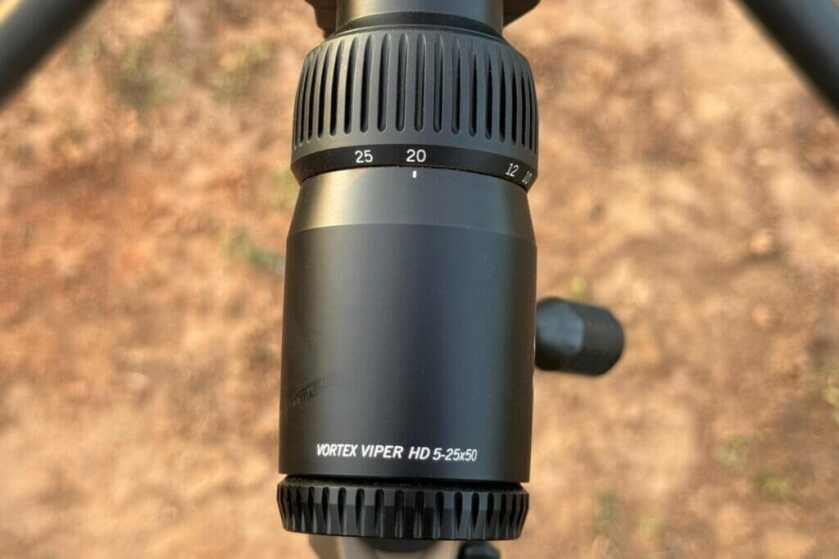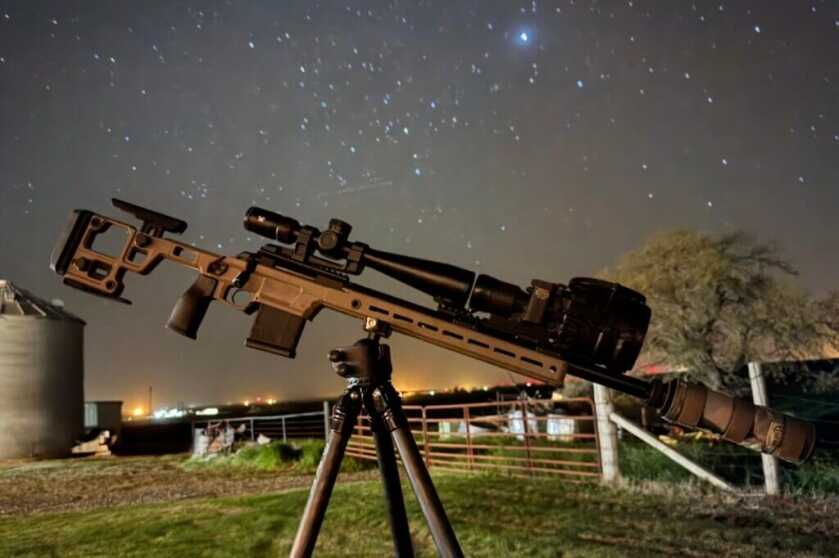Estimated reading time: 9 minutes
Vortex has recently unveiled its latest lineup of scopes for 2024, and one standout addition is the Viper HD 5-25X50. Featuring a second focal plane (SFP) design, this rifle scope comes equipped with Vortex’s VMR-3 reticle, enabling shooters to make holdovers at extended distances without the need to adjust shot settings manually. With its illuminated reticle, capped windage, and a secure locking elevation turret, the Viper HD 5-25X50 is engineered to offer hunters and long-range shooters an affordable, durable, and adaptable solution.

Table of contents
Vortex Viper HD 5-25 SFP Specifications:
- Magnification: 5-25x
- Objective Lens Diameter: 50 mm
- Focal Plane: Second Focal Plane (SFP)
- Reticle: VMR-3
- Turret Style: Capped
- Tube Size: 30 mm
- Adjustment Graduation: 0.1 MRAD
- Parallax Setting: 20 Yds – ∞
- Max Windage Adjustment: 12.4 MRAD
- Max Elevation Adjustment: 20 MRAD
- Travel Per Rotation: 10 MRAD
- Field of View: 24′-4.7′
- Eye Relief: 3.4″
- Length: 15.2″
- Weight: 25.0 oz
Out of the Box
Straight from the factory, Vortex equips this scope with all essential accessories except for the rings. Inside the package, you’ll find a sunshade, CR2032 battery, turret cap tool, scope cover, lens cloth, RevStop™ insert, and, of course, the scope. Additionally, the package includes an owner’s manual and a reticle pamphlet.

Mount
Every scope requires a reliable mount to squeeze out every ounce of performance possible. For this reason, I chose to pair the Viper HD 5-25 with Vortex’s own 30mm Precision Extended Cantilever mount. This rugged one-piece mount proved to be a great pairing for this scope review. I spent the duration of this review using this combo mounted up on an Aero Precision SOLUS chambered in 308 without an issue.
SEE MORE: New Scope Review: Meet the Vortex Venom 1-6X24

Reticle On The Viper HD 5-25
When it comes to scopes, the most interesting thing in my mind is the reticle. Although excellent glass and other features play a role, the reticle can truly make or break a scope for me. The VMR-3 is crafted to enhance long-distance shooting and ranging capabilities. While it gets the job done, I lean towards the “Christmas tree” style of reticle for long-range shooting. That’s why I’d opt for this scope with the VMR-4 reticle over the one I tested. The VMR-3 is straightforward, keeping users focused without unnecessary distractions. However, I do wish Vortex had at least included numbers alongside the elevation etchings for quicker referencing. While it only takes a few extra seconds to count the markings for holdover shots, time is often of the essence.
A crucial point to note about the second focal plane (SFP) scopes is that holdovers are accurate only at a specific magnification setting. In the case of the Viper HD 5-25, this sweet spot is at 20X magnification. So, if you attempt a 600-yard shot with a 4 MIL hold while zoomed in at just 5X, you’ll overshoot the target by a long shot. However, at 20X magnification, all holds are spot-on. Despite the reticle remaining constant at any magnification, I found it user-friendly when fully zoomed in. The holds proved effective, and navigating with the VMR-3 reticle felt intuitive. I even managed to hit targets at distances of up to 1045 yards using only the etched reticle holds. This was done without ever touching the elevation turret.
Magnification
One of the most interesting aspects of this scope is an included detent at 20X magnification. This feature swiftly halts the magnification precisely where the reticle holds are calibrated. Initially, I was taken aback, wondering if something was broken, but the SFP Viper HD 5-25 is intentionally engineered to halt at 20X. It’s simple to twist beyond this to zoom in up to 25X, yet it enables users to swiftly locate the magnification required to utilize the reticle holdovers.

I appreciate this unique decision, as I hardly ever take shots with the scope zoomed in all the way. This provides a wider field of view when making a shot while still providing extra magnification if needed. Also, if the elevation turret is used to dial in shots, the magnification setting does not matter. This is only needed when using the reticle to hold for windage and elevation.
Illumination
To enhance low-light performance, Vortex incorporates an illuminated reticle into the Viper HD 5-25. Powering this is a single CR2032 battery. With the left-hand side control button, users can select from ten brightness settings. Simply press the button once to activate the illuminated center dot. Subsequent button presses adjust the brightness level incrementally. When at maximum or minimum brightness, the dot flashes, indicating the adjustment direction reversal. To reverse the adjustment direction, users must reach the maximum or minimum setting. Turning off the illumination is as easy as holding the rubber control button for 4 seconds. Upon reactivation, the illumination maintains its previous setting.

Having tested this scope in various lighting conditions, I must mention that the illuminated reticle isn’t what you’d call “daylight bright.” Nevertheless, it offers a helpful contrast when aiming against dark backgrounds, even though it’s not as radiant as a red dot.

Turrets
I appreciate the capped windage and locking elevation turret on the Viper HD 5-25. They’re great for preventing accidental adjustments when the scope gets bumped around which is common when the rifle is slung when out hunting. Once zeroed, I never touch the windage dial. I always use the reticle to hold for ever-changing windage. The elevation turret however can simply be pulled up to be adjusted and then pressed down to be locked in place. Each adjustment has a distinct click, and the caps are clearly labeled making them quite easy to use.

Moreover, the elevation turret incorporates Vortex’s RevStop™ Zero System, offering a toolless zero stop for a reliable return to zero after making turret adjustments. It’s easy to install and locks out adjustments of more than 0.5 MRAD below the zeroed-out setting. This feature eliminates any confusion about how many rotations the scope has undergone and instills confidence in always returning back to zero.

Tracking With the Viper HD 5-25
One of the most important mechanical functions of a modern scope is its ability to precisely dial in shots. Deciding to test how well the turrets worked, I zeroed a laser to the center of the reticle at 20ish yards and then dialed up 8.5 mils.
When I was looking through the scope, the laser was centered exactly on the 8.5-mil line etched on the reticle to prove the scope is tracking appropriately. I then proceeded to zero and dial the scope 5 mills to the right, and the laser looked to be spot on as well. When I dialed both windage and elevation back to zero, the laser returned perfectly to the center of the reticle. This was a win and the Viper HD 5-25 proved to have its mechanical turrets precisely tracked with the etched reticle hash marks.
Clarity
The Viper HD 5-25 utilizes Vortex’s HD optical system which delivers great resolution, light transmission, and edge-to-edge sharpness. Throughout my time with this scope, I experienced no discernible distortion, enjoying consistent clarity from one edge of the field of view to the other. This remained true at any magnification. Additionally, the scope is argon purged and features fully multi-coated glass, ensuring an anti-reflective coating and enhanced light transmission.
READ MORE: Testing the New Vortex Viper HD 3-15 SFP!
Vortex Viper HD 5-25 Performance
Throughout my review, this scope served me well. I never had any sort of issues, and I was able to shoot steel silhouettes out to 1045 yards with ease. I was even able to shoot a 9″ rabbit target at 900 yards. Measuring 15.2″, the scope may feel a tad lengthy, but for long-range shooting, it gets the job done. My only real complaint is that I am personally not a fan of the VMR-3 reticle. However, Vortex offers a front focal plane VMR-4 option for the Viper HD 5-25, which seems to align better with my needs. Regardless, having options is always a plus.

Summary of the Vortex Viper HD 5-25 SFP
Aiming to get information out at the time of the launch, Vortex sent this scope to me in advance so I could start testing it out and give y’all feedback. I first shot with it in December up in Wisconsin, but for the past month or so I have been running it down in Oklahoma and Texas. I am happy to report that it ran great and I never encountered any issues. This scope features solid turrets, an illuminated reticle, and great glass while being backed by the Vortex Lifetime Warranty. The new Vortex Viper HD 5-25X50 is available and shipping now with the current street price hovering around the $900 mark for the VMR-3 reticle, and $1,000 for the VMR-4.
*** Buy and Sell on GunsAmerica! ***












How much doe s.you= pistols run.do you shi